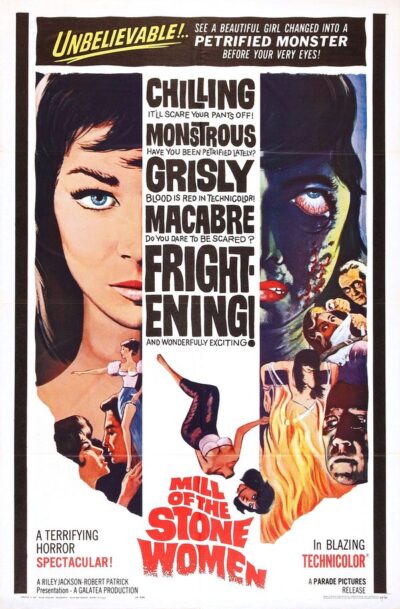 According to Mondo Macabro co-chairman Pete Tombs, this 1960 French-Italian co-production is a “minor classic” of Euro-horror. “Minor” is an accurate designation for a striking but largely unmoving film that premiered around the same time as (and was vastly overshadowed by) Mario Bava’s classic BLACK SUNDAY.
According to Mondo Macabro co-chairman Pete Tombs, this 1960 French-Italian co-production is a “minor classic” of Euro-horror. “Minor” is an accurate designation for a striking but largely unmoving film that premiered around the same time as (and was vastly overshadowed by) Mario Bava’s classic BLACK SUNDAY.
MILL OF THE STONE WOMEN (LE MOULIN DES SUPPLICES) claims to be based on a (nonexistent) short story by “Pieter Van Weigen,” an author who, according to (fake) articles put out as part of the film’s publicity campaign, was a “literary magician of the macabre” inspired by the art of Heironymous Bosch. The film, in any event, received some good critical notices in its day but quickly fell into obscurity.
Hans (Pierre Brice), a reporter, arrives in the village of Veeze, Netherlands, to write a profile of the famed sculptor Professor Gregorius Wahl (Herbert Boehme). He resides at the “Mill of the Stone Women,” a rural windmill where the professor runs a circus-like show in which stone women sculptures, their features twisted into macabre configurations, get paraded before the public—who are often terrified by what they see. Hans quickly finds himself bewitched by the only non-stone female to be found: Wahl’s fetching daughter Elfie (Scilla Gabel), for whom he neglects his wife Liselotte (Danny Carrell).
But then one night Hans attempts to consummate his longings, only to have Elfie seemingly drop dead in his arms. This leads to an extended hallucinatory passage after he unwisely accepts a spiked drink offered by Wahl, who in the hallucination suggests that Hans was directly responsible for Elfie’s death. The following day, however, Elfie turns back up, alive and seemingly well.
She has in fact died, just as, it turns out, she did many times previously. Elfie suffers from a rare blood disease her father has been trying to alleviate with a heart machine created by one Dr. Bolem (Wolfgang Preiss). It’s being used to administer blood transfusions taken from young women art students, whose corpses Wahl turns into stone sculptures. His latest designated victim: Liselotte, who it’s up to Hans to save.
The film is justly famous for its gorgeous old school Technicolor visuals, with colors that all-but bleed off the screen, and a striking ad campaign that failed to convey Ferroni’s poetic sheen (and gives away the major twist with the tagline “Why Do Warm-Blooded Beauties Suddenly Turn to Stone?”). Ferroni’s visuals at times reach Mario Bava heights despite issues with source illumination (as in a shot in which Wahl crosses a set, illuminated by wholly unjustified spotlighting) and the fact that most available prints tend to be cut (with a nipple glimpse by the Italian sexpot Scilla Gabel, one of the film’s initial selling points, being MIA from most American prints).
In most other respects the film is too subdued, certainly in contrast to its antecedents, which include I VAMPIRI (1957) and EYES WITHOUT A FACE/ Les yeux sans visage (1960). The insane brilliance of those films is nowhere to be found in MILL OF THE STONE WOMEN, which features hallucination scenes that tend toward the obvious (with echoey voices, in the English language dubs especially, bluntly connoting the fact that we’re in un unreal realm). Even the final scenes, with their close-up depictions of burning bodies and melting faces, aren’t as wild as they’re supposed to be—meaning I disagree with Tombs’ description of a “gruesome climax where all the stops are pulled out and we move into a kind of pure cinematic delirium that rivals moments from NOSFERATU or CALIGARI…” Not quite.
Vital Statistics
MILL OF THE STONE WOMEN (LE MOULIN DES SUPPLICES)
C.E.C. Films/Faro Film/Wanguard Film
Director: Georges Ferroni
Producer: Gian Paolo Bigazzi
Screenplay: Remigio del Grosso, Louis Souvat
Cinematography: P.L. Pavoni
Editing: Antonietta Zita
Cast: Pierre Brice, Scilla Gabel, Wolfgang Preiss, Danny Carrel, Marco Guglielmi, Liana Orfei, Herbert Boehme, Olga Solbelli, Alberto Archetti
